Cheese sticks can be a delicious and convenient snack option, but understanding their nutritional content, specifically their carb content, is important. Knowing what you’re consuming can help you make informed choices about your snacking habits and ensure that you’re maintaining a balanced diet. So, let’s delve into the nutritional breakdown of cheese sticks and discover what they have to offer.
- Cheese sticks have an average serving size of 3 ounces.
- They contain about 22.8 grams of total carbs and 21.8 grams of net carbs.
- The fiber content is 1 gram, while the sugar content is 2 grams.
- Cheese sticks provide 13.8 grams of protein and 15.6 grams of fat, including 5.8 grams of saturated fat.
- They are a good source of calcium, iron, magnesium, phosphorus, and zinc.
- Consider portion control and balance cheese sticks with other nutritious foods.
Now that we have a basic understanding of the nutritional content of cheese sticks, let’s explore their breakdown in more detail. In the next section, we’ll take a closer look at their carb, fiber, sugar, protein, and fat content, as well as the vitamins and minerals they provide. Stay tuned for an in-depth nutritional guide to cheese sticks!
The Nutritional Breakdown of Cheese Sticks
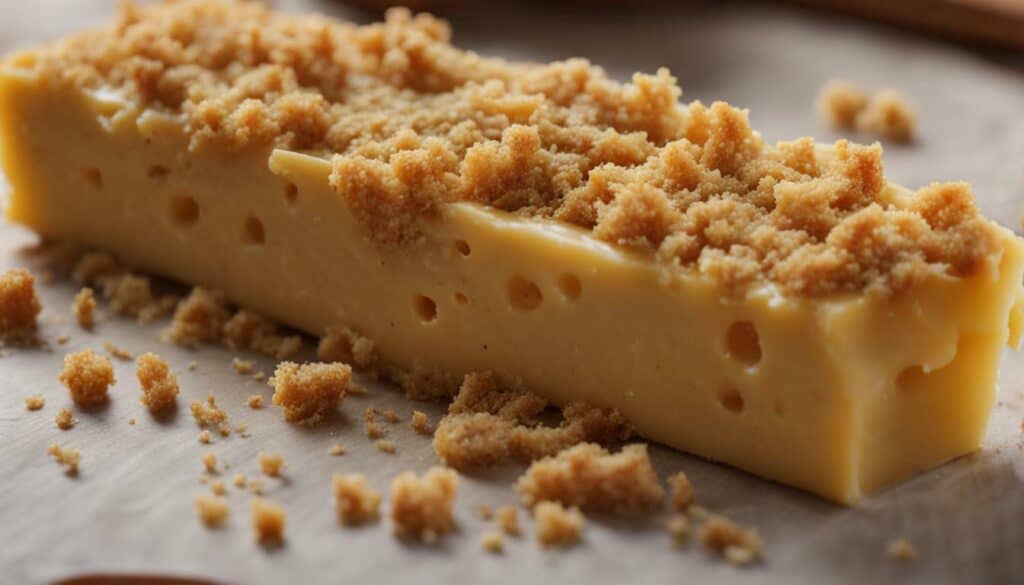
When it comes to the nutritional composition of cheese sticks, there are key details to consider, including their carb content, fiber and sugar content, protein and fat content, and essential vitamins and minerals. According to the sources, the average serving size of cheese sticks is 3 ounces, which contains about 22.8 grams of total carbs and 21.8 grams of net carbs.
Let’s take a closer look at the breakdown:
| Nutrient | Amount per 3 ounces |
|---|---|
| Total Carbs | 22.8 grams |
| Net Carbs | 21.8 grams |
| Fiber | 1 gram |
| Sugar | 2 grams |
| Protein | 13.8 grams |
| Fat | 15.6 grams |
| Saturated Fat | 5.8 grams |
It’s important to note that cheese sticks also provide essential nutrients. They are a good source of calcium, providing about 15-20% of the recommended daily intake. Additionally, they contain important minerals like iron, magnesium, phosphorus, and zinc.
While cheese sticks can be a satisfying snack option, it’s crucial to consume them in moderation. They may contain sodium, lactose, and saturated fat, so it’s important to balance them with other nutritious foods within a well-rounded diet. Remember to practice portion control and make informed choices about your snacking habits.
Overall, cheese sticks can be enjoyed as part of a balanced diet, providing protein and essential nutrients. Incorporate them mindfully into your snack routine, and explore low carb options or even try making homemade cheese sticks for a healthier alternative.
Types of Cheese Sticks and Their Variations
Not all cheese sticks are created equal, and there are various types and variations that cater to different dietary needs, including low carb and keto options. These variations offer a delicious way to enjoy cheesy snacks while still maintaining a low carb lifestyle.
One popular option is low carb cheese sticks, which are made with low carb ingredients and have a reduced carb content compared to traditional cheese sticks. These are a great choice for those following a low carb or keto diet, as they provide a satisfying snack without compromising on taste.
For those who love the flavor of cheese but are looking to further reduce their carb intake, keto cheese sticks are a fantastic option. These cheese sticks are specifically crafted to be extremely low in carbs, making them an ideal choice for those adhering to a strict ketogenic diet.
When it comes to cheesy snacks that are low in carbs, the options don’t end with cheese sticks. There are other delicious alternatives to explore, such as cheese crisps or cheese crackers. These crispy, cheesy snacks often have minimal carb content and can be a fantastic addition to a low carb or keto diet.
Table: Types of Cheese Sticks
| Type | Description | Carb Content |
|---|---|---|
| Low Carb Cheese Sticks | Made with low carb ingredients, suitable for those following a low carb diet | Varies, but generally lower than traditional cheese sticks |
| Keto Cheese Sticks | Specifically crafted to be extremely low in carbs, ideal for those on a ketogenic diet | Very low, typically less than 1 gram of carbs per serving |
| Cheese Crisps/Crackers | Crispy, cheesy alternatives to traditional cheese sticks with minimal carb content | Varies, but generally low in carbs |
Whether you’re looking for a low carb snack or a keto-friendly option, cheese sticks and their variations provide a tasty and satisfying solution. Just remember to check the carb content and choose the option that best fits your dietary needs and preferences.
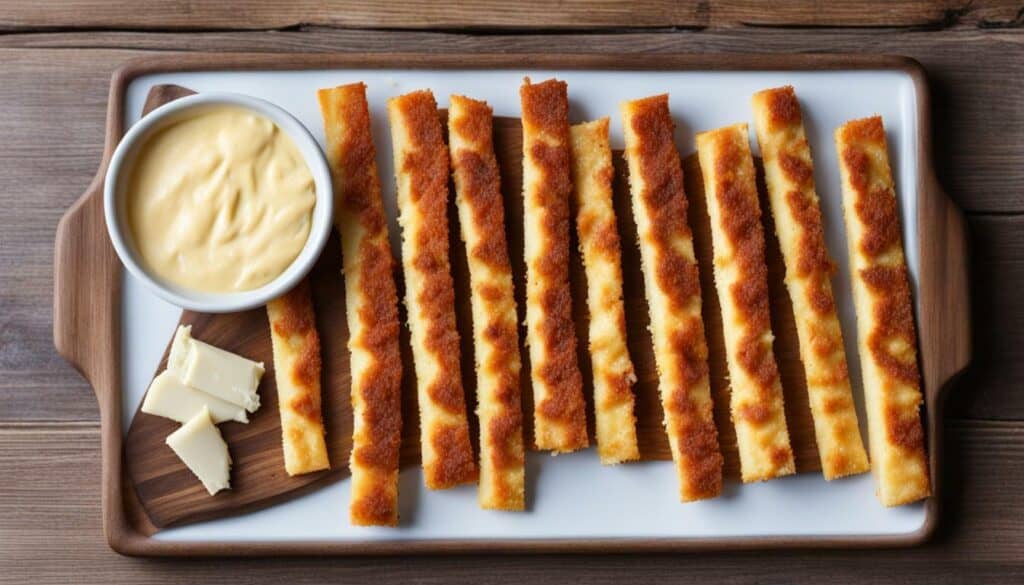
Making your own cheese sticks at home can be a healthier alternative, allowing you to customize the ingredients and preparation method to suit your dietary preferences. By using quality ingredients and opting for healthier cooking methods, you can enjoy a delicious snack without compromising your health goals.
When making homemade cheese sticks, you have the freedom to choose the type of cheese you prefer, whether it’s a low-fat option or a more flavorful variety like cheddar or mozzarella. You can also control the amount of salt and other seasonings added to suit your taste.
To create a healthier version of cheese sticks, try baking them instead of deep frying. This method reduces the amount of added oil and results in a crispy texture without the excess grease. Simply coat your cheese sticks in a mixture of breadcrumbs, herbs, and spices, then bake them in the oven until golden brown.
By making your own cheese sticks, you can be confident in the quality and nutritional value of the ingredients. You can avoid additives and preservatives commonly found in store-bought options, making your homemade version a healthier snack choice.
Next time you’re craving cheese sticks, consider giving homemade ones a try. Not only will you have control over the ingredients, but you’ll also have the satisfaction of knowing that you’re making a healthier choice for yourself and your loved ones.
Portion Control and Moderation
While cheese sticks can be a satisfying snack, it’s crucial to practice portion control and moderation to maintain a healthy diet. These cheesy treats may be delicious, but overindulging can lead to consuming excessive calories, saturated fat, and sodium. To ensure you’re enjoying cheese sticks in a balanced way, here are some helpful tips:
- Stick to the recommended serving size of 3 ounces, which typically equates to around two cheese sticks.
- Pair cheese sticks with other nutritious foods, such as fresh vegetables or whole grain crackers, to create a well-rounded snack.
- Consider portioning out individual servings in advance to prevent mindless snacking.
- Keep in mind that cheese sticks are not a meal replacement, but rather a snack to be enjoyed in moderation.
To illustrate the importance of portion control, let’s compare the nutritional content of two servings of cheese sticks versus a single serving:
| Two Servings (6 ounces) | One Serving (3 ounces) | |
|---|---|---|
| Total Carbs | 45.6 grams | 22.8 grams |
| Net Carbs | 43.6 grams | 21.8 grams |
| Protein | 27.6 grams | 13.8 grams |
| Fat | 31.2 grams | 15.6 grams |
| Saturated Fat | 11.6 grams | 5.8 grams |
Remember, moderation is key when it comes to enjoying cheese sticks. It’s all about finding the right balance between indulgence and maintaining a healthy lifestyle.
A Variety of Low-Carb Snack Ideas
In addition to portion control, incorporating a variety of low-carb snacks into your diet can help satisfy your cravings while supporting your health goals. Here are some delicious and nutritious options to consider:
- Crispy kale chips seasoned with olive oil and a sprinkle of parmesan cheese.
- Sliced cucumbers topped with cream cheese and smoked salmon.
- Roasted chickpeas tossed in your favorite spices for a satisfying crunch.
- Hard-boiled eggs sprinkled with a pinch of salt and pepper.
- Almonds or other nuts, a great source of healthy fats and fiber.
By incorporating these low-carb snack ideas into your routine, you can enjoy a wide range of flavors while maintaining a balanced and nutritious diet.
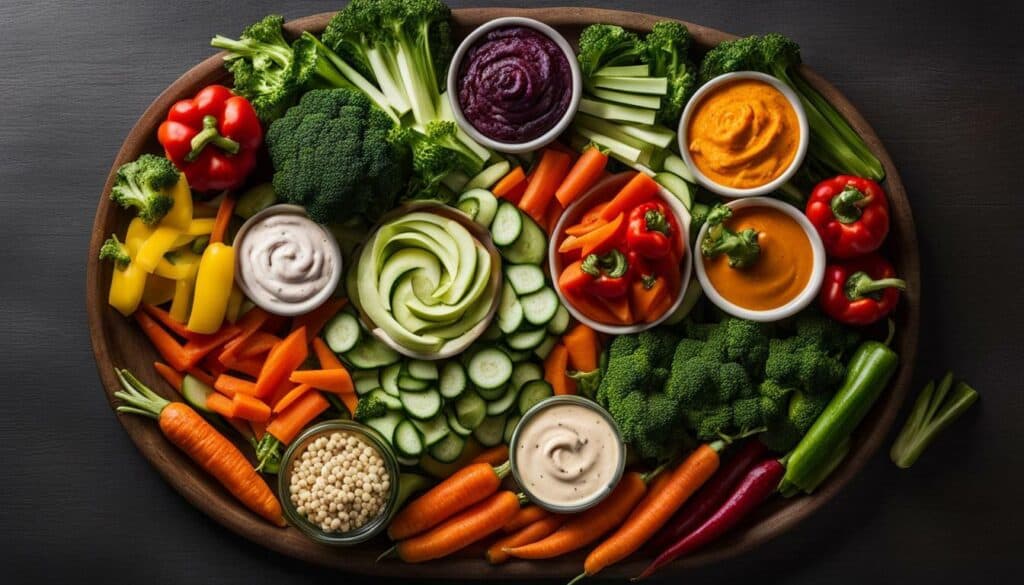
Remember to consult with a healthcare professional or registered dietitian to determine the best snacking approach for your individual needs and dietary preferences.
The Impact of Milk Type on Cheese Stick Nutrition
The type of milk used to make cheese sticks can affect their nutritional profile, including their fat content, which is important to consider when opting for low carb cheese sticks. While most cheese sticks are made from cow’s milk, there are also options available that are made from goat’s milk or sheep’s milk. Each type of milk has its own unique composition, which can have an impact on the nutritional content of the cheese sticks.
For those looking for low carb options, it’s important to note that cheese sticks made from goat’s milk or sheep’s milk tend to have a lower carbohydrate content compared to cheese sticks made from cow’s milk. This is because goat’s milk and sheep’s milk naturally contain less lactose, which is the sugar found in milk. As a result, cheese sticks made from these types of milk can be a suitable choice for those following a low carb or ketogenic diet.
Additionally, cheese sticks made from goat’s milk or sheep’s milk may also have a slightly different fat content compared to those made from cow’s milk. Goat’s milk and sheep’s milk contain higher levels of medium-chain fatty acids (MCTs), which are known for their potential health benefits, including aiding in weight loss and providing a source of quick energy.
The Nutritional Composition of Cheese Sticks by Milk Type:
| Milk Type | Carbohydrates (per serving) | Fat (per serving) | Protein (per serving) |
|---|---|---|---|
| Cow’s Milk | 22.8 grams | 15.6 grams | 13.8 grams |
| Goat’s Milk | 18 grams | 14 grams | 8 grams |
| Sheep’s Milk | 19 grams | 14 grams | 7 grams |
It’s important to note that the nutritional composition of cheese sticks can still vary slightly depending on the specific brand or manufacturer. It’s always a good idea to check the nutrition label for accurate information on the carbohydrate and fat content of the cheese sticks you are consuming.
In summary, the type of milk used to make cheese sticks can influence their fat and carbohydrate content. Goat’s milk and sheep’s milk cheese sticks tend to have a lower carbohydrate content compared to those made from cow’s milk, making them a suitable option for those following a low carb diet. However, it’s important to consider individual dietary needs and preferences when choosing cheese sticks, and to consume them in moderation as part of a balanced diet.
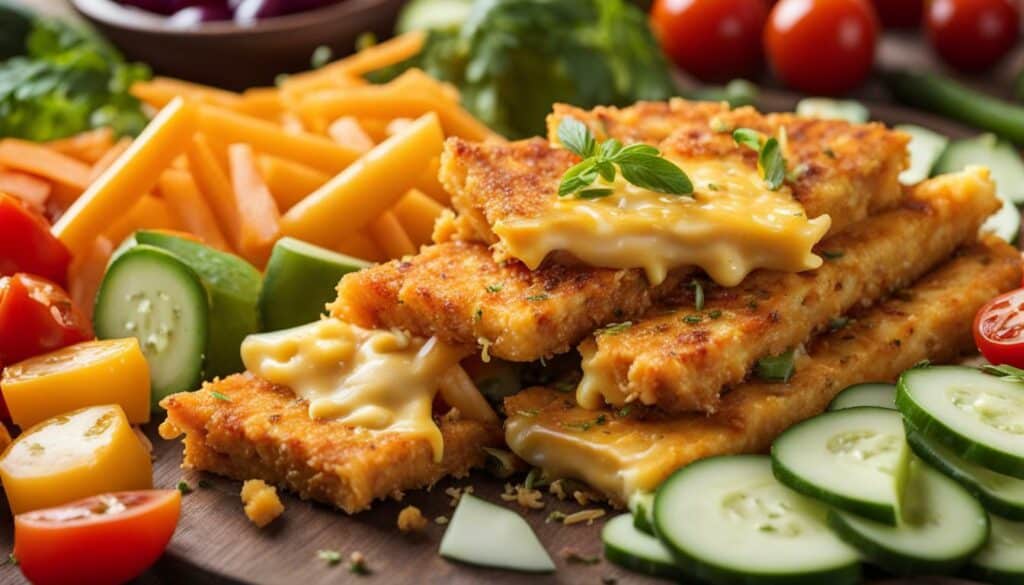
Potential Concerns and Considerations
While cheese sticks can be a healthy snack option, it’s important to be aware of potential concerns, such as sodium, lactose, and saturated fat content, and consume them in moderation. Cheese sticks may contain varying levels of sodium, depending on the brand and type of cheese used. Excessive sodium intake can contribute to high blood pressure and increase the risk of heart disease.
For individuals with lactose intolerance or lactose sensitivity, cheese sticks may cause digestive discomfort. Lactose is the natural sugar found in milk and dairy products, and some people who have trouble digesting lactose may experience bloating and gastrointestinal symptoms when consuming cheese sticks.
Furthermore, cheese sticks can have a relatively high saturated fat content, which can contribute to elevated cholesterol levels and increase the risk of cardiovascular disease when consumed in excess. It’s essential to monitor saturated fat intake and incorporate cheese sticks into a balanced diet alongside other nutrient-rich foods.
| Concern | Consideration |
|---|---|
| Sodium | Choose low-sodium cheese stick options or enjoy them in moderation to reduce sodium intake. |
| Lactose Intolerance | If you have lactose intolerance, consider lactose-free or alternative cheese stick options. |
| Saturated Fat | Balance cheese stick consumption with low-fat or lean protein options to manage saturated fat intake. |
By understanding these potential concerns and making informed choices, you can enjoy cheese sticks as part of a healthy diet. Remember to practice portion control, incorporate a variety of nutrient-rich foods, and consult a healthcare professional if you have specific dietary restrictions or health concerns.
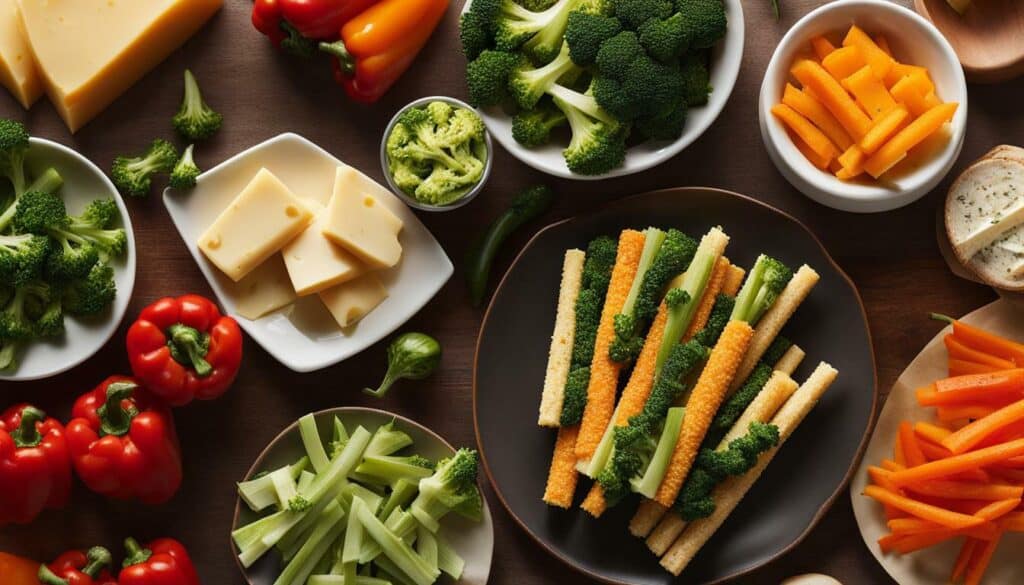
To make the most of cheese sticks as a snack option, it’s essential to incorporate them into a balanced diet by pairing them with other nutritious foods. They can be a great addition to a low carb or keto diet due to their relatively low carb content. When enjoying cheese sticks, consider adding a variety of low carb snacks to create a satisfying and well-rounded snacking experience.
Here are some low carb snack ideas that you can combine with cheese sticks:
- Crunchy vegetables like celery, cucumber, or bell peppers paired with a low carb dip or hummus.
- Olives, pickles, or marinated artichoke hearts for a tangy and flavorful snack.
- Hard-boiled eggs, which are packed with protein and essential nutrients.
- Nuts and seeds like almonds, walnuts, or pumpkin seeds for a crunchy and satisfying snack.
- Sliced avocado or guacamole for a creamy and nutritious pairing.
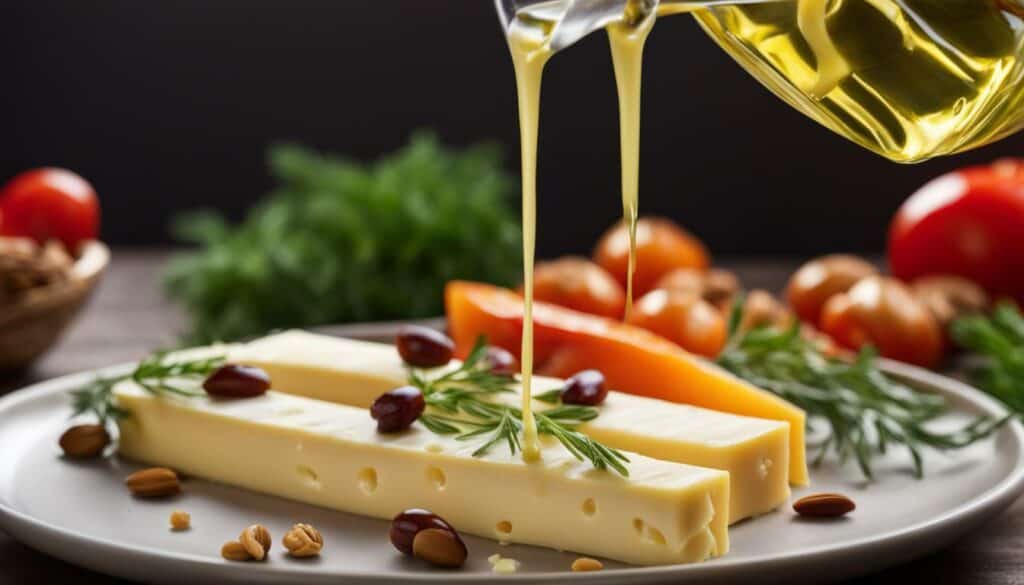
By combining cheese sticks with these low carb snack options, you can enjoy a balanced and satisfying snack that provides a good balance of protein, healthy fats, and essential nutrients. Remember to practice portion control and listen to your body’s hunger cues to avoid overeating.
Snack Smart and Enjoy!
Snacking can be a healthy and enjoyable part of a balanced diet. Incorporating cheese sticks into your snacking routine can provide a convenient and tasty option that complements a low carb or keto lifestyle. Just keep in mind the nutritional content, portion control, and balance it with other nutritious foods. Snack smart and enjoy!
Conclusion
Understanding the nutritional content of cheese sticks, including their carb content, allows for informed snacking choices that can contribute to a balanced and healthy diet. According to sources, the average serving size of cheese sticks is 3 ounces, which contains about 22.8 grams of total carbs and 21.8 grams of net carbs. Cheese sticks also provide 1 gram of fiber and 2 grams of sugar. It’s important to note that they also contain 13.8 grams of protein and 15.6 grams of fat, with 5.8 grams of saturated fat.
While cheese sticks can be a tasty snack option, it’s crucial to consume them in moderation due to potential concerns such as sodium, lactose, and saturated fat. Portion control plays a significant role in maintaining a balanced diet, and pairing cheese sticks with other nutritious foods can enhance their benefits. It’s also worth mentioning that the type of milk used to make cheese sticks can impact their nutritional content, particularly in terms of fat content.
Overall, cheese sticks can be a satisfying and convenient snack that provides essential nutrients like calcium, iron, magnesium, phosphorus, and zinc. By being mindful of portion sizes and incorporating cheese sticks into a well-rounded diet, individuals can enjoy the deliciousness of cheese sticks while making healthier snacking choices.
FAQ
Q: Are cheese sticks a healthy snack option?
A: Cheese sticks can be a satisfying snack option that offers protein and essential nutrients. However, it’s important to consider portion control and balance them with other nutritious foods in a well-rounded diet.
Q: How many carbs are in an average serving of cheese sticks?
A: An average serving size of cheese sticks is 3 ounces, which contains about 22.8 grams of total carbs and 21.8 grams of net carbs.
Q: What vitamins and minerals are found in cheese sticks?
A: Cheese sticks are a good source of calcium, providing about 15-20% of the recommended daily intake. They also contain essential nutrients like iron, magnesium, phosphorus, and zinc.
Q: Can I make homemade cheese sticks?
A: Yes, you can make homemade cheese sticks as a healthier alternative. Baked low carb cheese sticks are easy to prepare and can be a delicious snack option.
Q: What should I consider when consuming cheese sticks?
A: It’s important to consume cheese sticks in moderation due to their potential sodium, lactose, and saturated fat content. Pairing them with other nutritious foods and practicing portion control is essential.
Q: How does the type of milk used to make cheese sticks affect their nutrition?
A: The type of milk used can impact the fat content of cheese sticks. Different types of milk can result in variations in overall nutrition, especially in terms of low carb options.
Q: How can I incorporate cheese sticks into a balanced diet?
A: Cheese sticks can be incorporated into a balanced diet by pairing them with other nutritious foods. Consider low carb snack ideas such as pairing them with vegetables or enjoying them with whole grain crackers.
What is the Nutritional Information for Cheese Sticks?
If you are curious about the nutritional information for cheese sticks, it’s important to understand the key details. The term nutritional information explained refers to the breakdown of the nutrients present in cheese sticks, such as calories, fat, protein, and carbohydrates. By examining this information, you can make informed dietary choices and determine the suitability of cheese sticks for your nutritional needs.





Leave a Reply